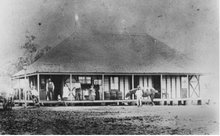I hear a lot of nostalgia for the past from people with whom I mix. There is a trope common to many Western societies that we have lost valuable ways of doing things from the past --ways that called on notions of respect, taking time about things, appreciating that making something of worth takes time. The whole Slow Food movement is an example of this kind of turning back to older ways of doing things. I have a lot of sympathy for this perspective, but it is very much a product of prosperous societies with the money and time for nostalgia. To paraphrase apologists for China’s human rights record “When you are trying to survive every day, you don’t have much time for human rights (or Slow Food for that matter.)”
What brought these thoughts to mind was making chutney yesterday. I started peeling and chopping vegetables and fruit at 3.30pm and was bottling the chutney at 9pm. Perhaps it was my inexperience, perhaps the fact that I also helped with homework, read with the kids, made rafts of vegemite toast for afternoon tea, cooked dinner and juggled a few other things in between, but it seemed like a major investment of time for 6 ½ bottles of admittedly gorgeous smelling and looking chutney (I haven’t had a moment to taste it properly yet.) I know that I will feel a great sense of satisfaction when these jars are tucked next to other presents under the Christmas tree and even more when I am spooning it out onto my sausages in a few months time. But when I think of the time and physical resources that went into this, I have to wonder if it is worth it.
My brother and his family live in Central Asia. Preserving food is an essential part of life for them. If they don’t bottle fruit and vegetables frantically in their short summer, there is nothing but rice, cheese and fat sheep for the winter. They don’t have time or the resources for elaborate pickled or sweetened concoctions. It is a matter of getting the fruit and vegetables to last under the easiest possible methods of preservation. They don’t have much electricity. While it is cotton picking season they have a few hours of electricity in the evenings but when the itinerant workers leave, so does the power supply. Spending five hours boiling a chutney would be a waste of time and precious energy. Cooking it over the wood stove would be a profligate use of fuel unless they were cooking something else at the same time or heating the house.
I suspect that it was a lot like this for early migrants to Queensland. Preserving food would have been a skill taught to every German daughter by her mother. This kind of food would have been essential for surviving cold northern hemisphere winters. Migrants would have been ready to continue this tradition but it wasn’t really necessary once they arrived in Queensland. In this part of southeast Queensland, vegetables can be grown year round outside. The main problem is shade and water in summer, not cold temperatures, frost and snow. Down in the valleys, frost lies on the coldest winter days but many of the hillsides are above the frost-line. People can and do grow tropical fruit in their back gardens. And for fruit that requires chilling time to grow, there’s the Granite Belt over the other side of Cunningham’s Gap. It must have seemed like some kind of food paradise.
Preserving changed from being an essential part of everyday life, to being an optional extra. Later still came refrigeration, freezers and supermarkets. I wonder if this is why people retain traditional ways of jam and chutney-making, the value-added luxury end of preserving and the simpler preserving methods have died out.
Subscribe to:
Post Comments (Atom)

No comments:
Post a Comment